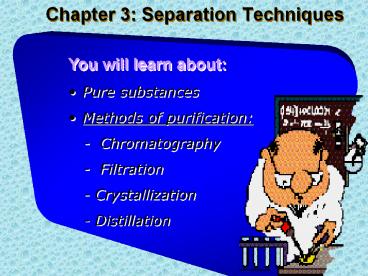Chapter 3: Separation Techniques PowerPoint PPT Presentation
1 / 29
Title: Chapter 3: Separation Techniques
1
Chapter 3 Separation Techniques
- You will learn about
- Pure substances
- Methods of purification
- - Chromatography
- - Filtration
- - Crystallization
- - Distillation
2
How do we know which are the real products?
3
Testing for Purity
4
(i) Chromatography
- A technique using a solvent to separate a mixture
into its components. - E.g separate dyes in ink, detect traces of banned
food substances, identify poisons or drugs.
5
Procedure
- Food colouring is applied to chromatography
paper. - The paper is dipped into a solvent.
(e.g water, alcohol) - The solvent travels up the paper, dissolving and
carrying the dye along with it. - Coloured spots are seen in different positions on
the paper at the end of results.
6
(No Transcript)
7
Who wrote the ransom note?
8
(No Transcript)
9
(No Transcript)
10
Culprit
11
Ben Johnson stripped from his Olympic goldin
1988.
12
ii) Filtration separating a solid from liquid
13
- A mixture is poured into the filter funnel lined
with filter paper. - Liquid particles are small enough to go through
the pores of the filter paper but the solid
particles are too large to go through. - Collect the filtrate that passes through the
filter paper in a conical flask. The solid that
remains in the filter paper is called residue.
14
iii) Evaporation to Dryness Crystallisation
15
Procedure
1. Pour some distilled water into the mixture to
dissolve the soluble substance. 2. Filter the
mixture. 3. Wash the residue with a little
distilled water to remove all the salt solution
from it. The residue is sand.
4. Evaporate the filtrate to dryness. Salt is
recovered.
16
iv) Distillation separating a liquid from a
solution
17
Procedure
- Solution is heated in a flask until the solution
boils. - Pure liquid turns into a vapour and leaves the
flask - Vapour is then cooled by a condenser, which
changes it back into a liquid - Liquid is called the distillate and is collected
in a conical flask.
18
How does simple distillation work?
2. In the condenser, water vapour condenses.
3. Pure water is collected as distillate.
1. In the distillation flask, water boils and
enters the condenser.
19
SAFETY MEASUREMENTS
Thermometer
This ensures that the thermometer measures the
boiling point of the substance that is being
distilled.
Boiling Chips
To ensure smooth boiling.
20
If the distillate is volatile, the receiver can
be put in a large container filled with ice.
This helps to keep the temperature of the
distillate low so that it remains in the liquid
state.
21
Eg. Finding out the dyes present in sweets
22
Paper chromatography
- a method of separating identifying mixtures.
- a suitable solvent is used.
23
(No Transcript)
24
(No Transcript)
25
- Purity of Substances
- pure substances have fixed melting and boiling
points - melting points and boiling points are changed by
the presence of impurities
26
(No Transcript)
27
(No Transcript)
28
(No Transcript)
29
(No Transcript)

